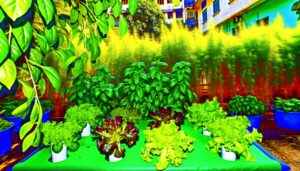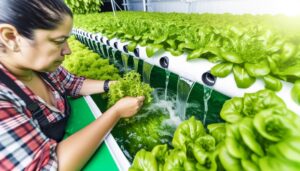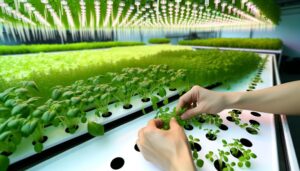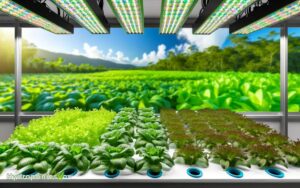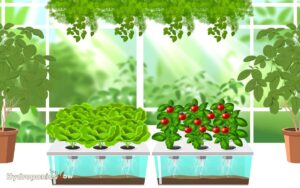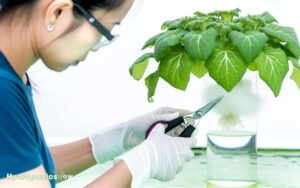Learn Hydroponics: 3 Steps to Growing Plants Without Soil
When you grow plants without soil, it’s called hydroponics. This method involves immersing roots in nutrient-rich water solutions, which boosts growth rates, yields, and nutrient absorption.
You can fine-tune nutrient levels, pH, and water usage, greatly reducing water consumption and eliminating soil-borne diseases.
Hydroponics encompasses various systems like Nutrient Film Technique, delivering nutrients directly to roots, and Deep Water Culture, submerging roots in nutrient solutions.
Utilizing inert mediums like coconut coir for root support guarantees excellent aeration and stability. With precise control over the plant environment and nutrient delivery, hydroponics offers many advantages over traditional soil-based gardening.
Discover more about its fascinating benefits and techniques.
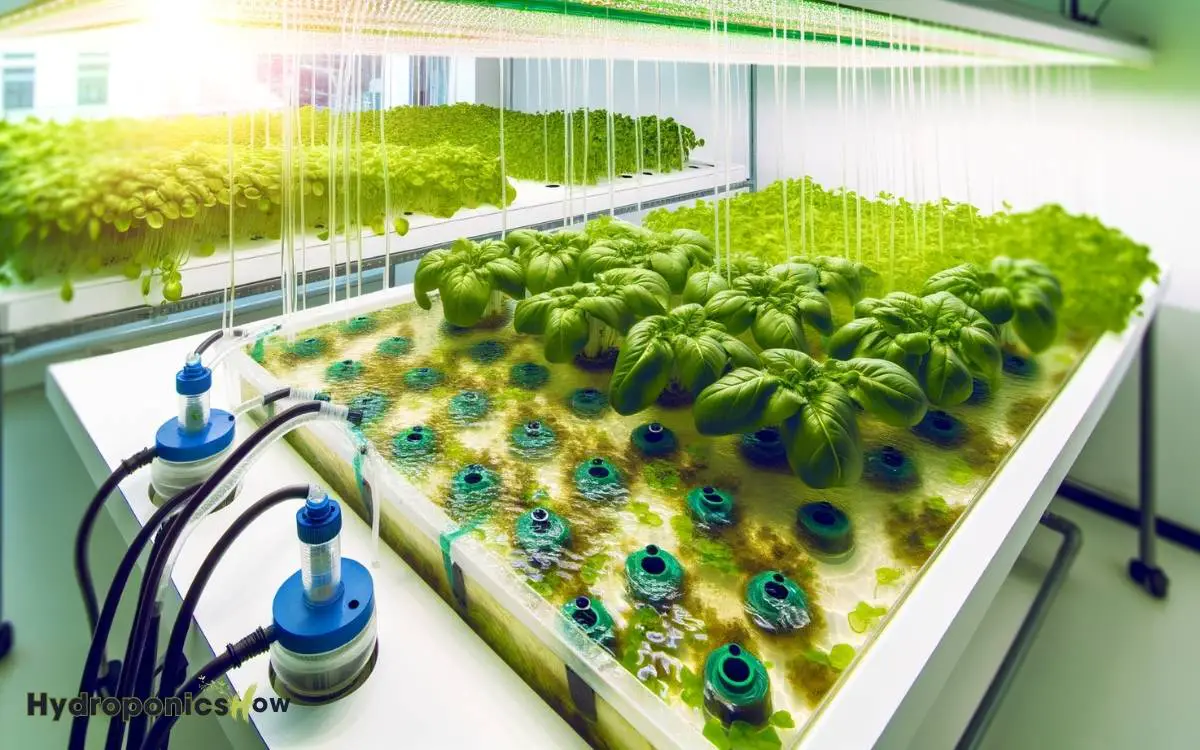
Key Takeaways
What Is Hydroponics?
Hydroponics, a method of growing plants without soil, utilizes nutrient-rich water solutions to deliver essential minerals directly to plant roots. This technique promotes faster growth and higher yields compared to traditional soil-based cultivation. Although hydroponic systems typically do not use soil, some growers may choose to plant hydroponic sponges in soil to transition seedlings from a controlled environment to an outdoor garden. This hybrid approach can help young plants adapt while still benefiting from their early hydroponic growth phase.
In this system, plants are supported using inert mediums like perlite or coco coir, which provide stability without interfering with nutrient uptake.
By bypassing soil, hydroponics allows for precise control over nutrient levels, pH balance, and water quality. This control can lead to faster growth rates and higher yields compared to traditional soil-based cultivation.
Additionally, hydroponics minimizes water usage by recirculating the nutrient solution, making it a more sustainable option. Studies have shown that hydroponic systems can reduce the risk of soil-borne diseases, improving overall plant health.
This method is ideal for urban farming and areas with poor soil conditions.
History of Hydroponics
Tracing its roots back to ancient civilizations, the concept of growing plants without soil has evolved greatly over centuries. The Hanging Gardens of Babylon, one of the Seven Wonders of the Ancient World, likely utilized early hydroponic techniques.
Ancient Aztecs developed “chinampas,” floating gardens in shallow lake beds. In 1627, Francis Bacon’s book ‘Sylva Sylvarum‘ detailed water culture experiments, marking significant progress.
By the 20th century, Dr. William F. Gericke of the University of California popularized hydroponics in modern agriculture, demonstrating large-scale cultivation. NASA later adopted hydroponics for space missions, illustrating its advanced capabilities.
Your understanding of hydroponics’ rich history underscores its scientific and practical evolution, paving the way for innovative agricultural practices today.
How Hydroponics Works
In hydroponics, you immerse plant roots in a nutrient-rich water solution, providing essential minerals directly.
This method eliminates the need for soil, using alternative root support systems like clay pellets or rock wool to stabilize plants.
Research shows that precise control over nutrient delivery and plant environment can lead to faster growth and higher yields.
Nutrient-Rich Water Solution
While traditional farming relies on soil for nutrients, hydroponics delivers essential minerals directly through a meticulously balanced water solution. This solution, enriched with macro and micronutrients, guarantees plants receive ideal nourishment.
You’ll find elements like nitrogen, phosphorus, potassium, calcium, magnesium, and trace elements such as iron and zinc dissolved in the water.
By controlling the pH and electrical conductivity (EC) levels, you can customize the nutrient mix to match the specific needs of each plant species.
Research shows that this precise nutrient delivery system can enhance growth rates, increase yields, and improve overall plant health.
Monitoring the solution regularly, adjusting nutrient concentrations based on plant developmental stages and environmental conditions, ensures continuous, balanced nutrition.
Root Support Systems
To guarantee plants remain upright and their roots well-oxygenated, hydroponic systems utilize various inert mediums like coconut coir, perlite, and clay pellets to provide essential structural support. These substrates don’t supply nutrients but aid in root aeration and moisture retention.
Understanding the properties of each medium helps you choose the best option for your setup:
- Coconut Coir: Derived from coconut husks, it retains moisture well and has a neutral pH.
- Perlite: A volcanic glass that provides excellent aeration and drainage.
- Clay Pellets: Also known as LECA, they offer stability and are reusable.
- Rockwool: Made from spun volcanic rock, it has high water retention and is often used for seedlings.
Each medium promotes optimal root health and plant growth.
Benefits of Hydroponics
Hydroponics, by providing plants with nutrient-rich solutions directly to their roots, greatly enhances growth rates and yields compared to traditional soil-based methods.
You’ll find that plants grown hydroponically absorb nutrients more efficiently, leading to faster maturation. This method also allows for precise control over nutrient levels, pH, and water usage, ensuring ideal growth conditions.
Additionally, hydroponics minimizes soil-borne diseases and pests, resulting in healthier plants. It’s an environmentally sustainable approach, reducing water consumption by up to 90% and eliminating the need for harmful pesticides.
Studies indicate that hydroponic systems can produce up to 30% more yield than soil-based agriculture, making it a highly efficient alternative for modern farming.
Types of Hydroponic Systems
You should first understand the Nutrient Film Technique (NFT), which utilizes a thin film of nutrient-rich water that continuously flows over plant roots.
Additionally, Deep Water Culture (DWC) requires submerging roots directly in an oxygenated, nutrient-filled solution. Both systems offer unique advantages and challenges based on your specific cultivation needs.
Nutrient Film Technique
Among the various hydroponic methods, the Nutrient Film Technique (NFT) stands out for its efficiency in delivering nutrients directly to plant roots through a continuous, thin film of nutrient-rich water.
You’ll find that NFT systems offer several benefits for effective cultivation:
- Optimal Oxygenation: The thin nutrient film guarantees roots receive ample oxygen.
- Efficient Water Use: Continuous recirculation minimizes water waste.
- Nutrient Management: Precise control over nutrient concentrations enhances plant health.
- Scalability: Easily adaptable for both small-scale and large-scale operations.
In NFT, a shallow stream of nutrient solution flows over the roots within a sloped channel, ensuring uniform nutrient uptake. This method is particularly advantageous for fast-growing plants like lettuce and herbs, making it a preferred choice for commercial growers.
Deep Water Culture
In Deep Water Culture (DWC), plants are suspended with their roots submerged directly in a nutrient-rich, oxygenated water solution, promoting rapid growth and robust health.
You’ll find that the continuous availability of nutrients and oxygen is crucial for excellent plant development. Airstones and air pumps are typically employed to maintain dissolved oxygen levels in the water, preventing root rot and other issues.
Research indicates that DWC systems can yield faster growth rates compared to traditional soil-based methods due to the direct nutrient uptake.
Additionally, you can easily monitor and adjust the pH and nutrient concentrations, ensuring precise control over the growing environment.
This method is particularly effective for growing leafy greens, herbs, and other fast-growing plants.
Common Plants for Hydroponics
Hydroponic systems often promote plants like lettuce, spinach, and herbs due to their relatively short growth cycles and minimal nutrient demands.
These plants are ideal for hydroponics because they grow rapidly and adapt well to nutrient-rich, water-based environments.
Here’s a list of common plants you should consider for your hydroponic setup:
- Lettuce: Its fast growth rate and low nutrient requirements make it a staple in hydroponics.
- Spinach: This leafy green thrives in hydroponic systems, offering high yields in a short period.
- Basil: Known for its aromatic leaves, basil flourishes with hydroponic nutrient solutions.
- Tomatoes: Though more nutrient-demanding, tomatoes produce substantial yields and are a popular choice among hydroponic gardeners.
These plants promote a productive and efficient use of your hydroponic system.
Starting Your Hydroponic Garden
Starting your hydroponic garden requires careful planning and understanding of essential components like nutrient solutions, lighting, and growth mediums.
- First, select an appropriate nutrient solution tailored to your plant species, making sure it contains the necessary macro and micronutrients.
- Next, invest in a reliable lighting system, such as LED grow lights, which provide the full spectrum of light needed for photosynthesis.
- Additionally, choose a suitable growth medium like rockwool or coco coir to support root development and nutrient absorption.
- Monitor pH levels regularly, maintaining them between 5.5 and 6.5 for best nutrient uptake.
- Lastly, ensure adequate water circulation and oxygenation using air pumps and water pumps to maintain a healthy root environment.
Your meticulous preparation will lead to thriving plants.
Conclusion
Hydroponics offers a fascinating way to grow plants efficiently and sustainably. Did you know hydroponic systems can use up to 90% less water than traditional soil gardening? That’s a significant saving, especially in water-scarce regions.
By embracing hydroponics, you’re not just nurturing plants; you’re also contributing to environmental conservation.
So why not start your own hydroponic garden and experience the benefits firsthand? It’s a step towards a more sustainable and innovative future in agriculture.

